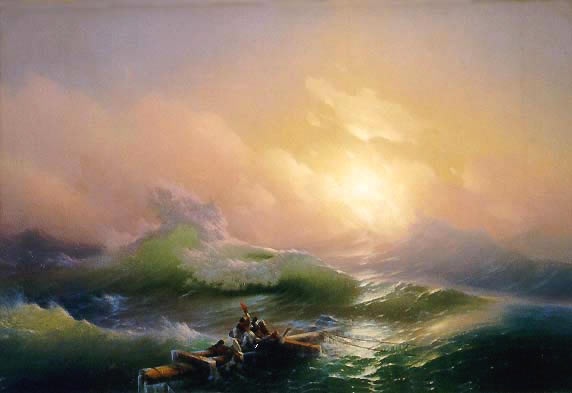AIVAZOVSKY, IVAN (1817-1900) Russian landscape painter.
Ivan Aivazovsky: “The Ninth Wave” – 1850 – oil on canvas – Saint Petersburg, State Museum
Born in Crimea in 1817, to an Armenian family, is arguably the most famous Russian seascape painter. The quality of his paintings made him one of the most respected artists in Russia, earning the Gold Medal at the Saint Petersburg Academy of Arts, and opening his own school at home town of Feodosiya. Aivazovsky painted more than 6,000 works, most notably the famous “The ninth wave”, and a large group of large paintings glorifying the Russian navy. Today Aivazovsky is the most sought-after 19th century Russian painter, and his works are sold for more than $3 million at auctions.
“The ninth wave” is a true masterwork. Aivazovsky reaches in this painting an absolute technical perfection, representing a group of unlucky castaways trying to survive under the merciless charges in form of oceanic waves. Nevertheless, the centre of the composition is the powerful, almost mystical and diffuse representation of the sun, which illuminates the scene with a strange, oneiric range of green and pink shades. This painting is often called “the most beautiful painting in Russia”

1881 – oil on canvas – The Tretyakov Gallery, Moscow, Russia
Son of a Greek shoemaker who emigrated to Mariupol (now Ukraine), Arkhip Kuindzhi (1842-1910) was one of the most important 19th century Russian painters, quite influenced by previous masters as Ivan Aivazovsky. Kuindzhi was a professor in the Saint Petersburg Academy of Arts untill he was fired for support student’s protests.
“Dnepr in the morning” (as “Dnepr in the night”, executed a year before) is considered as one of the first works finished with Kuindshi’s “mature” style, with stunning light and atmospheric effects. This panoramic view is especially remarkable for its simple but very strong composition.
“Dnepr in the morning” (as “Dnepr in the night”, executed a year before) is considered as one of the first works finished with Kuindshi’s “mature” style, with stunning light and atmospheric effects. This panoramic view is especially remarkable for its simple but very strong composition.

1900 – oil on canvas
“Lake” is Levitan’s last painting, an unfinished masterpiece by the Russian painter (born in Kaunas, Lithuania) who mastered the landscape of mood, a very emotional interpretation of the Russian landscape.
While Levitan, as many other Russian landscape painters, was clearly influenced by the Barbizon School, this late work is (un)finished in a somewhat impressionist way.

1871 – oil on canvas – Tetryakov Gallery, Russia
Savrasov was one of the most important -arguably the most important- of all the 19th century Russian landscape painters, considered the creator of the “lyrical landscape style”. A trully emblematic work, “the rooks have returned” (or “the rooks have come back”) is Savrasov’s most famous painting, a lovely elegy to the spring announced by the rooks return The canvas shows Savrasov’s love for the rural Russian landscape, very influenced by John Constable. One of Savrasov’s most famous pupils is Isaac Levitan.

1886 – oil on canvas – Tetryakov Gallery, Russia
Ivan Shishkin (1832-1898) was one of the most important 19th century Russian landscape painters. He was a very famous artist in life, being a professor of painting in the Imperial Academy of Saint Petersburg and in the Higher Art School of Moscow
“Morning in a pine forest” is a marvelous pictorial fantasy that goes beyong the pure realism developed by many other Russian painters of the era. Shishkin has chosen one of his favorite motifs, the dense Russian pine forest, adding the unusual and rather bucolic presence of a family of bears

1872 – oil on canvas – The Tretyakov Gallery, Moscow, Russia
Died at the age of 23 victim of a tuberculosis, Feodor Vasilyev was a brillian “boy genius” who established himself as one of the most important and respected Russian painters of his era, introducing the lyrical landscape style in Russian painting. “Wet meadow” is a beautiful, lyric masterwork done completely from memory and a few sketches of the Russian plains.
Vasilyev was a fierce competitor to Ivan Shishkin, who was later accused of predujice Vasilyev using his important influences.

















